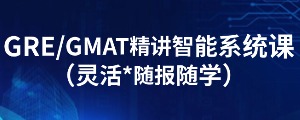选课中心
7099人选课
GMAT公开讲座
0元
GRE公开讲座
0元
一对一体验课
99元
GMAT模考网站
10000人
GRE模考网站
GMAT课程
GRE课程
托福辅导课程
【定制】1v1
私人订制
资料下载
考前冲刺

扫码添加助教
免费领取
备考资料大礼包

扫码关注公众号
新东方在线GMAT频道为大家带来GMAT阅读文章练习七,希望对大家GMAT备考有所帮助。更多精彩尽请关注新东方在线GMAT频道!
Between the eighth and eleventh centuries A. D., the Byzantine Empire staged (to produce or cause to happen for public view or public effect “stage a track meet” “stage a hunger strike”) an almost unparalleled economic and cultural revival, a recovery that is all the more striking because it followed a long period of severe internal decline. By the early eighth century, the empire had lost roughly two-thirds of the territory it had possessed in the year 600, and its remaining area was being raided by Arabs and Bulgarians, who at times (at times: adv.有时, 不时) threatened to take Constantinople and extinguish the empire altogether. The wealth of the state and its subjects was greatly diminished, and artistic and literary production had virtually ceased. By the early eleventh century, however, the empire had regained almost half of its lost possessions, its new frontiers were secure, and its influence extended far beyond its borders. The economy had recovered, the treasury was full, and art and scholarship had advanced.
To consider the Byzantine military, cultural, and economic advances as differentiated aspects of a single phenomenon is reasonable. After all, these three forms of progress have gone together in a number of states and civilizations. Rome under Augustus and fifth-century Athens provide the most obvious examples in antiquity. Moreover, an examination of the apparent sequential connections among military, economic, and cultural forms of progress might help explain the dynamics of historical change.
The common explanation of these apparent connections in the case of Byzantium would run like this: when the empire had turned back enemy raids on its own territory and had begun to raid and conquer enemy territory, Byzantine resources naturally expanded and more money became available to patronize art and literature. Therefore, Byzantine military achievements led to economic advances, which in turn led to cultural revival.
No doubt this hypothetical pattern did apply at times during the course of the recovery. Yet it is not clear that military advances invariably came first, economic advances second, and intellectual advances third. In the 860’s the Byzantine Empire began to recover from Arab incursions so that by 872 the military balance with the Abbasid Caliphate had been permanently altered in the empire’s favor. The beginning of the empire’s economic revival, however, can be placed between 810 and 830. Finally, the Byzantine revival of learning appears to have begun even earlier. A number of notable scholars and writers appeared by 788 and, by the last decade of the eighth century, a cultural revival was in full bloom (in full bloom: adv.开着花), a revival that lasted until the fall of Constantinople in 1453. Thus the commonly expected order of military revival followed by economic and then by cultural recovery was reversed in Byzantium. In fact, the revival of Byzantine learning may itself have influenced the subsequent economic and military expansion.
1. Which of the following best states the central idea of the passage?
(A) The Byzantine Empire was a unique case in which the usual order of military and economic revival preceding cultural revival was reversed.
(B) The economic, cultural, and military revival in the Byzantine Empire between the eighth and eleventh centuries was similar in its order to the sequence of revivals in Augustan Rome and fifth century Athens.
(C) After 810 Byzantine economic recovery spurred a military and, later, cultural expansion that lasted until 1453.
(D) The eighth-century revival of Byzantine learning is an inexplicable phenomenon, and its economic and military precursors have yet to be discovered.
(E) The revival of the Byzantine Empire between the eighth and eleventh centuries shows cultural rebirth preceding economic and military revival, the reverse of the commonly accepted order of progress.
2. The primary purpose of the second paragraph is which of the following?
(A) To establish the uniqueness of the Byzantine revival
(B) To show that Augustan Rome and fifth-century Athens are examples of cultural, economic, and military expansion against which all subsequent cases must be measured
(C) To suggest that cultural, economic, and military advances have tended to be closely interrelated in different societies
(D) To argue that, while the revivals of Augustan Rome and fifth-century Athens were similar, they are unrelated to other historical examples
(E) To indicate that, wherever possible, historians should seek to make comparisons with the earliest chronological examples of revival
3. It can be inferred from the passage that by the eleventh century the Byzantine military forces
(A) had reached their peak and begun to decline
(B) had eliminated the Bulgarian army
(C) were comparable in size to the army of Rome under Augustus
(D) were strong enough to withstand the Abbasid Caliphate’s military forces
(E) had achieved control of Byzantine governmental structures
4. It can be inferred from the passage that the Byzantine Empire sustained significant territorial losses
(A) in 600
(B) during the seventh century
(C) a century after the cultural achievements of the Byzantine Empire had been lost
(D) soon after the revival of Byzantine learning
(E) in the century after 873
5. In the third paragraph, the author most probably provides an explanation of the apparent connections among economic, military, and cultural development in order to
(A) suggest that the process of revival in Byzantium accords with this model
(B) set up an order of events that is then shown to be not generally applicable to the case of Byzantium
(C) cast aspersions on traditional historical scholarship about Byzantium
(D) suggest that Byzantium represents a case for which no historical precedent exists
(E) argue that military conquest is the paramount element in the growth of empires
6. Which of the following does the author mention as crucial evidence concerning the manner in which the Byzantine revival began?
(A) The Byzantine military revival of the 860’s led to economic and cultural advances.
(B) The Byzantine cultural revival lasted until 1453.
(C) The Byzantine economic recovery began in the 900’s.
(D) The revival of Byzantine learning began toward the end of the eighth century.
(E) By the early eleventh century the Byzantine Empire had regained much of its lost territory.
7. According to the author, “The common explanation” (line 28) of connections between economic, military, and cultural development is
(A) revolutionary and too new to have been applied to the history of the Byzantine Empire
(B) reasonable, but an antiquated theory of the nature of progress
(C) not applicable to the Byzantine revival as a whole, but does perhaps accurately describe limited periods during the revival
(D) equally applicable to the Byzantine case as a whole and to the history of military, economic, and cultural advances in ancient Greece and Rome
(E) essentially not helpful, because military, economic, and cultural advances are part of a single phenomenon
参考答案:ECDB BDC
以上就为大家整理的“GMAT阅读文章练习七”,更多精彩内容,请关注新东方在线GMAT频道。
| GMAT直播VIP小班 | GMAT直播精讲班 | GMAT录播课 |
| (VIP小班/全科班+1对1) | (全科精讲/单项备考) | (全科班/单项班) |
| 72.5课时 ¥18800 | 61课时 ¥7796 | 134课时 ¥14680 |

 资料下载
资料下载
新东方GMAT佛脚词汇1.0版本
发布时间:2023-06-30添加新东方美研助教号
回复【资料】获取
新东方GMAT数学500题资料下载
发布时间:2023-05-26添加新东方美研助教号
回复【资料】获取
新东方GMAT800题资料下载
发布时间:2022-05-21添加新东方美研助教号
回复【资料】获取
1000句GMAT真实句子改错问题
发布时间:2022-04-17添加新东方美研助教号
回复【资料】获取
2024杨鹏阅读难句(GMAT+GRE)教程
发布时间:2022-04-17添加新东方美研助教号
回复【资料】获取
新东方GMAT数学500题(解析及答案)
发布时间:2019-11-27添加新东方美研助教号
回复【资料】获取
新东方GMAT800题(逻辑+语法+阅读)
发布时间:2019-11-27添加新东方美研助教号
回复【资料】获取
新东方GMAT佛脚词汇1.0版本
发布时间:2019-11-27添加新东方美研助教号
回复【资料】获取
GMAT词汇/长难句/语法资料大全
发布时间:2019-11-27添加新东方美研助教号
回复【资料】获取
GMAT语文考试圣经(Bible)电子版
发布时间:2019-11-27关注新东方在线美研订阅号
回复【GMAT】获取
GMAT推理圣经PDF电子版
发布时间:2019-11-27添加新东方美研助教号
回复【资料】获取
GMAT考试OG五个版本题号对照表
发布时间:2019-11-27添加新东方美研助教号
回复【资料】获取
GMAT Ultimate Grammar电子书籍PDF
发布时间:2019-11-27添加新东方美研助教号
回复【资料】获取

添加美研助教号,
回复【GMAT】获取备考必看资料包

 推荐阅读
推荐阅读
新东方在线GMAT频道为大家带来GMAT阅读复习的五大步骤,希望对大家GMAT备考有所帮助。更多精彩尽请关注新东方在线GMAT频道! 1:原来
新东方在线GMAT频道为大家带来GMAT阅读背景的培养,希望对大家GMAT备考有所帮助。更多精彩尽请关注新东方在线GMAT频道! 一、经济学
新东方在线GMAT频道为大家带来GMAT阅读复习效率不高怎么办,希望对大家GMAT备考有所帮助。更多精彩尽请关注新东方在线GMAT频道! 建
新东方在线GMAT频道为大家带来GMAT阅读提高速度的根本方法,希望对大家GMAT备考有所帮助。更多精彩尽请关注新东方在线GMAT频道! 1
新东方在线GMAT频道为大家带来GMAT阅读如何避免错误,希望对大家GMAT备考有所帮助。更多精彩尽请关注新东方在线GMAT频道! 要避免GMA
新东方在线GMAT频道为大家带来GMAT阅读技巧的提升,希望对大家GMAT备考有所帮助。更多精彩尽请关注新东方在线GMAT频道! GMAT阅读推
新东方在线GMAT频道为大家带来GMAT阅读备考的注意事项,希望对大家GMAT备考有所帮助。更多精彩尽请关注新东方在线GMAT频道! GMAT阅
新东方在线GMAT频道为大家带来GMAT阅读怎么提高自己的能力,希望对大家GMAT备考有所帮助。更多精彩尽请关注新东方在线GMAT频道! 建
新东方在线GMAT频道为大家带来GMAT阅读长句子的备考,希望对大家GMAT备考有所帮助。更多精彩尽请关注新东方在线GMAT频道! 1 首先
新东方在线GMAT频道为大家带来GMAT阅读水平怎么提高,希望对大家GMAT备考有所帮助。更多精彩尽请关注新东方在线GMAT频道! 下面就来


 GRE/GMAT直播精讲小班
GRE/GMAT直播精讲小班
 GRE/GMAT精讲智能系统课
GRE/GMAT精讲智能系统课
 托福直播/精讲课(30天/60天)
托福直播/精讲课(30天/60天)
 资料下载
资料下载
添加新东方美研助教号
回复【资料】获取
添加新东方美研助教号
回复【资料】获取
添加新东方美研助教号
回复【资料】获取
添加新东方美研助教号
回复【资料】获取
添加新东方美研助教号
回复【资料】获取
添加新东方美研助教号
回复【资料】获取
添加新东方美研助教号
回复【资料】获取
添加新东方美研助教号
回复【资料】获取
添加新东方美研助教号
回复【资料】获取
关注新东方在线美研订阅号
回复【GMAT】获取
添加新东方美研助教号
回复【资料】获取
添加新东方美研助教号
回复【资料】获取
添加新东方美研助教号
回复【资料】获取

 阅读排行榜
阅读排行榜
 相关内容
相关内容